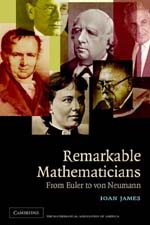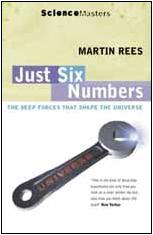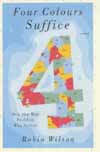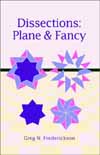Reviews and recommendations
'Remarkable mathematicians'It is not uncommon for physics students to know more about the history of physics than mathematics students do about the history of mathematics. Physical laws often come with a name attached; mathematics constitutes a more homogenous structure, and thus tracing parentage can be harder.
'The curious incident of the dog in the night-time'Despite what the innumerate masses may wish, our daily lives are inextricably tied up with mathematics. On the most mundane level, we use basic arithmetic to do such things as tell the time, to count our change, to programme the video. But on a less obvious level we also need a reasonably good grasp of geometry in order to park the car in the garage or to pack the shopping bags carefully at the supermarket; we collect and interpret statistical data when the football results come in and we all seem to know how easily order turns to chaos.
Two books about primesEarly in our mathematical careers, we are introduced to prime numbers. These special integers, which possess no divisors other than themselves and 1, are the building blocks for all the integers. Thus an understanding of the properties of primes, including where to find them, is an essential part of number theory, and any serious discussion of prime numbers will inevitably lead to what is arguably mathematics' greatest unsolved problem: The Riemann Hypothesis.
'Just six numbers'It seems amazing that the universe could be characterised by a mere six numbers, yet, according to Astronomer Royal Martin Rees, this is the case. He makes an excellent case for the necessity of these numbers, though he does not show that they are the only numbers we need.
'A short history of nearly everything'Bill Bryson - he's a travel writer isn't he? He goes places and writes about them, tells amusing anecdotes about things he sees and people he meets, making his readers laugh at the same time as teaching them something about the places he visits?
'The Code Book on CD-ROM'The Code Book on CD-ROM, by author Simon Singh and designer Nick Mee, is the interactive version of the best-selling book of the same title. Singh has already shown in The Code Book and Fermat's Last Theorem that he is an excellent communicator, able to explain complex ideas without using obscure jargon. But while the main achievement of The Code Book is to make codes and ciphers intelligible to everybody, the CD goes further and allows you to become a code builder and code breaker yourself. You will find yourself first turning into a code builder, fearful of being cracked, and then into a dedicated code breaker, following tips on how to crack the ciphers.
'Mindbenders and Brainteasers'Many people, when they look back, can pinpoint the precise moment when their interest in mathematics was awakened - it was when they found a puzzle that intrigued them. Perhaps they now realise the puzzle was trivial or insignificant, but at the time something about it captured their imagination and started them on a path that may have led very far - perhaps even into fundamental mathematical research.
'Four Colours Suffice'The Four Colour Theorem - the statement that four colours suffice to fill in any map so that neighbouring countries are always coloured differently - has had a long and controversial history. It was first conjectured 150 years ago, and finally (and infamously) proved in 1976 with much of the work done by a computer. The published proof relied on checking 1432 special cases, which took more than 1,000 hours of computer time.
'Dissections: Plane and Fancy'Geometric dissection is the mathematical art of cutting figures into pieces that can be rearranged to form other figures, preferably using as few pieces as possible. You may already have come across puzzles such as the Aviary Tangram, the pieces of which can be used to form an egg, a chicken and many other shapes; but the ingenuity of the dissections shown here may still be a revelation to you, as they were to this reviewer.
'Kepler's Conjecture'George Szpiro has a most unusual day job for someone writing about the abstract world of pure mathematics. Although he first studied maths at university, he has been a political journalist now for a number of years, working as Israel correspondent for NZZ, a Swiss daily. He wrote this book at night, after the paper's deadline, and as it was being finished lost one of his closest friends in a suicide bombing. The contrast between sphere packings in three dimensions and his daytime subject material must often have struck him.
'Scénes de ballet'Ballet and mathematics - not a combination that you often come across, but one that works beautifully in Frederick Ashton's 1948 ballet, Scénes de ballet. From the geometric patterns on the men's tunics and the perpendicular angle of the ballerina's tutu, to the movements and positioning of the dancers themselves, this ballet is a celebration of mathematics. Ashton was inspired by mathematics, and, according to the programme notes, used a system of Euclidean geometry to choreograph the piece.
'Conned again Watson!'Not many books about maths have chapters that start "The dead man seemed to stare at me in a most disconcerting way." But maybe more should - this book is a highly entertaining read, crossing sound mathematical exposition with the classic Sherlock Holmes style of investigation.









